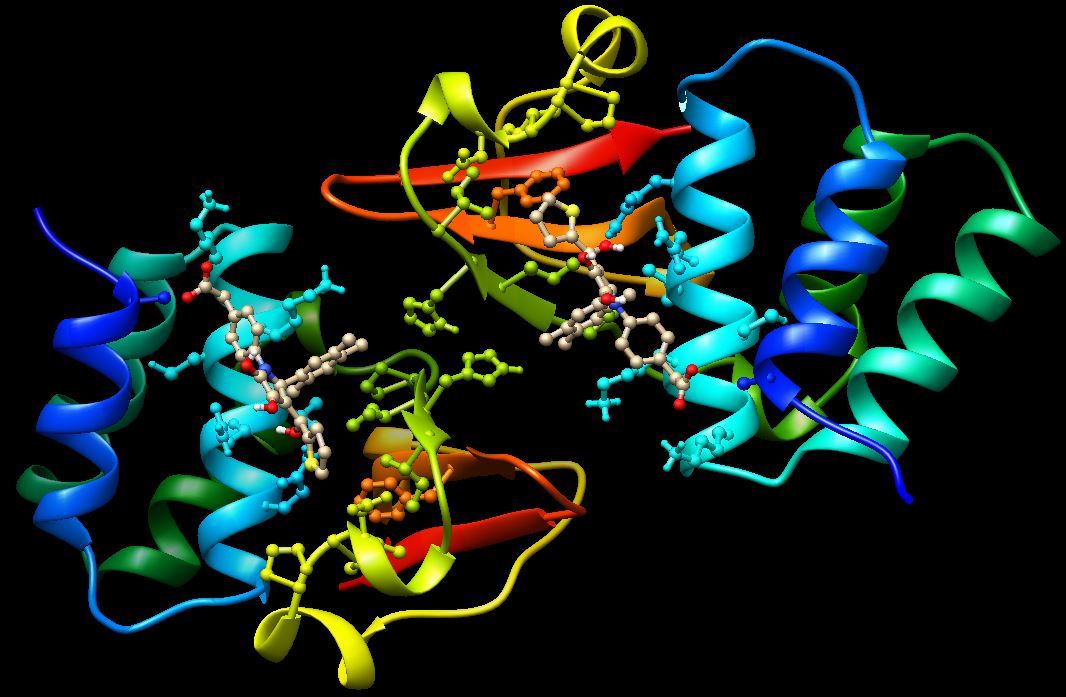Bioinformatics is a discipline that involves the use of computer science and biology to solve biomedical or biological problems. It utilizes large amounts of data and complicated datasets to make deductions which are useful in solving medical or biological problems. Through bioinformatics, the aetiology of diseases can be investigated at gene level and understood hence making the discipline a vital tool in medicine. In this course, the student is introduced to the concepts of Bioinformatics. Hands-on sessions will familiarize students with the details and use of common tools and resources. The course will cover the use of NCBI's Entrez and EBI's SRS, EMBL, GenBank, DDBJ and other biological databases, file formats, BLAST, PSI-BLAST, ClustalW, phylogenetic analysis, protein analysis, Pfam, PRINTS, BLOCKS, Prosite and the PDB and MMDB. Principles of drug design (both structure-based and ligand-based) will be covered in depth and topics in whole transcriptome shotgun sequencing (RNA SEQ), transcriptomics, systems biology, and metabolomics will also be covered. An introduction to database design and the principles of programming languages and HTML/CSS scripting and database design using MySQL will also be provided.
Hands-on sessions will familiarize students with the details and use of common tools and resources. The objective is to enhance the researchers’ capacity to conduct world class scientific research and boost their institution’s profile as a leading diagnostic and scientific centre. Continue Reading »
| Dates: January-March| April-June | July-September | October-December |
| Duration: 3 months. |
| Venue: Nairobi, Kenya. |
| PREREQUISITES |
This training is ideal for people in biological, agricultural, pharma, and biotechnology industries who wish to gain bioinformatics skills for analysis of biological data and discovery and design of in silico drugs and diagnostics. It is also ideal for computer scientists who have little biological knowledge and wish to gain bioinformatics skills. |
| FEES |
- Kshs. 70,000/- (Inclusive of VAT 16%) for East African residents. Non-East African students pay 25% more on all charges.Fee covers tuition, training material, certificate, drinks and meals only.
- Fees are payable strictly in advance (at least 4 working days before the starting date.
- Groups with a minimum of 5 people will enjoy a 10% discount and early bird registration (at least 2 weeks before the start) will be offered a 5% discount
- There will be a 10% administrative charge for cancellations received in writing up to 20 working days before the start of the course. No refunds will be made for cancellations received within 20 working days of the course start date or for the inability to attend the course for whatever reasons. KIBs is not liable for non-attendance due to travel disruptions, health problems or any other reason that might lead to a delegate not being able to attend the course. Substitutions may, of course, be made at any time, providing you inform us in writing.
- Fee is payable by bankers cheque or cash deposit to: Fee is payable by bankers cheque or MPESA to: Bioinformatics Institute of Kenya. A/C No. 01192845321700, Cooperative Bank, Co-op House Branch, Nairobi, Kenya. SWIFT Code KCOOKENAXXX. Branch Code: XXX. MPESA PAY BILL: Business number: 400222. Account number: 1679821#BIOINFO. PAYPAL: [email protected].
|
| REGISTRATION |
To register, please download the booking form fill it and send it to us through:
Email: [email protected]. |
| TOOLS AND SOFTWARE |
| A comprehensive list of tools and software is available in our Resources page |
| Course material including a comprehensive training manual and a CD with software |
| TRAINING PROGRAM |
|
WEEK 1: INTRODUCTION TO BIOINFORMATICS
Definition, scope, and applications of bioinformatics
- Comparative and evolutionary genomics
- Functional genomics and other omics
- Genome wide association analysis (GWAS)
- Drug discovery and design
- Personalized medicine
- Cancer research
- Gene therapy
- Preventive medicine
- Microbiology: biotechnology, bioremediation, epidemiological studies, antibiotic resistance
- Agriculture
Introduction to the LINUX system
- Installing the Java Virtual Machine (JVM)
- Installing BIOLINUX on JVM
- Adding Virtual Box Guest Additions on UBUNTU
- Linux GNOME terminal
- Bash command line for Linux
- Working with files in GEDIT
Overview of Biological Databases
- Primary nucleotide databases: GenBank, DDBJ, EMBL
- Secondary nucleotide databases
- Protein sequence databases: UniProt, PIR, SwissProt, PROSITE, InterPro, Pfam, Prints, SignalP
- Protein structure databases: RCSB, PDBe, PDBj, SCOP, CATH, PDBSum
- Databases of protein-protein interactions: STRING, BioGRID, GeoDataSets
- Databases of protein models: Swiss-model, ModBase, PMP
- Meta-databases: Entrez, GeneCards, mGen, BioGraph
- Literature databases: PubMed, PMC, Medline
- Enzyme databases: BRENDA
- Taxonomic databases: Taxonomy Browser
- RNA databases: Rfam, tmRDB, RDP, miRBase
- Carbohydrate structure databases: EuroCarbDB
- Network pathway databases: KEGG, Cytoscape
- Microarray databases: GEO, ArrayExpress
- Signal transduction pathway databases: Reactome, Netpath
- Specialized databases: OMIM, OMIA
- Genome databases: TAIR, Zebrafish information network, Wormbase, Xenbase, MGI Mouse Genome, RGD, SGD
| |
|
WEEK 2: DATABASE DESIGN & DEPLOYMENT
- Principles of database design
- HTML/CSS scripting
- PHP programming
- MySQL programming
- Exercises
| |
|
WEEK 3: SEQUENCE ANALYSIS
BLAST AND FASTA: A SEARCH FOR SIMILARITY
- Introduction and purpose
- Nucleotide blast
- Protein blast
- Blastx
- Tblastn
- Tblastx
- Gapped-blast, PSI-blast, PHI-blast, RPS-Blast
- Blast and information theory
- Karlin-Altschul statistics
- Blast scores and statistics
- Blast output
- UCSC Browser and BLAT
- Fasta
Sequence alignment
- Edit distance between 2 strings
- Global alignment
- Needleman-Wunsch Algorithm
- Local alignment
- Smith-Waterman algorithm
- Parametric alignment
- Suboptimal alignment
- Multiple alignment
- Scoring Matrices: PAM, BLOSUM 62, BLOSUM 50, BLOSUM 80
- Alignment Software: Multialign, ClustalW, MUSCLE, PileUp, Jalview, Mega
- Viterbi algorithm
- HMM
- Pairwise sequence alignment
- Parametric alignment
- Exercises and discussion
|
|
WEEK 4: PHYLOGENETICS
- Introduction to phylogeny
- Trees, nodes, leaf, bifurcating nodes, scaled trees, rooted tree, unrooted tree, scaled tree, rooted tree, gene tree, dentogram, cladogram, plesiomorphy, homoplasy, synapomorphy
- Min-ultrametric trees
- Ultrametric trees
- Molecular clock
- UPGMA algorithm
- Additive distance trees
- Fitch-margoliash algorithm
- NJ method
- Character-based methods for parsimony
- Parsimony
- Weighed parsimony
- Perfect phylogeny
- Phylogenetic alignment
- Exercises
|
|
WEEK 4: PROTEOMICS 1
|
|
WEEK 5: PROTEOMICS 2
|
|
WEEK 6: INTRODUCTION TO PERL PROGRAMMING
- Getting Started with Perl
- Perl Operators
- Input/Output
- Arrays and Sub-routines
- Pattern Matching
- Exercises
|
|
WEEK 7: PRINCIPLES OF DRUG DISCOVERY & DESIGN: DRY LAB SESSION
- Introduction to in-silico-based drug discovery and design and its place in the drug pipeline
- Target identification, obtaining crystallographic protein-ligand complexes from RCSB PDB, and homology modelling of protein targets
- Obtaining large ligand subsets using Wget from ZINC
- 1D/2D filtering of ligands using lead-likeness and Lipinski’s rule of five
- Preparation of coordinate files using Chimera 1.9
- Energy minimization using the Amber force field/CHARMM
- Protein-ligand re-docking and docking using the AutoDock Tools/Vina
- Analysis of docking results
- Identification of ligand binding sites through blind docking
- Virtual screening using PyRx and Raccoon
- Analysis of virtual screening results using FOX and the summarize_results.py script
- Ligand-based drug design and pharmacophore building
- Molecular dynamics using Gromacs
- In-silico based ADME-tox
|
|
WEEK 8: TRANSCRIPTOMICS
- Introduction to microarrays and HT experiments
- Biological background: DNA, proteins, and the central dogma, genes and protein synthesis, nucleic acid hybridization, Microarray technology and expression measuresThe Microarray Data Analysis (MDA) process
- Experimental design
- Variability sources
- Replication
- Power and sample size
- Pooling
- Single versus dual channel microarray design
- Preprocessing
- Quality control
- Background correction and normalization
- Statistical analysis: Class comparison, Multiple testing, Class discovery, Class prediction, Pathway analysis, Microarray bioinformatics, Software for microarray data analysis, Microarray databases
- Limitations of microarrays
- RNA/SEQ
- Advantages of RNA SEQ
- RNA SEQ Pipeline
- Lab Exercises: Microarray Analysis using R Programming Tool and Bioconductor
|
|
WEEK 9: SYSTEMS BIOLOGY AND METABOLOMICS
- Definition and scope of systems biology
- Definition and scope of metabolomics
- Applications of metabolomics: Biomarker discovery, Pathway analysis, Model construction, Systems biology, Toxicology
Metabolomics workflow
- Experimental design
- Sample preparation: Extraction, Chromatography, Ionization efficiency maximization
- Sample analysis by MS and NMR and GC/LC-MS Data output
- Pre-processing data analysis: Conversion of LC/MS data to mZXML,mZXML data preprocessing using XCMS, statistical analysis: univariate, multivariate, and modeling techniques
- Metabolite identification: Selection of interesting features, identification of metabolites, database search: KEGG, Metlin, HMDB, BMRB, LIPIDMAPS, KNApSAck, Metabolights, Hypothesis generation
- Experimental validation: Targeted metabolomics using LC and GC-triple quadrupole MS
- Molecular biology techniques: Immunohistochemistry, RT-PCR, GE array and cell cultures
- Lab exercises
|
|
Continuous Assessment Tests (C.A.T.s) on week 4 and week 9
WEEK 12: AWARD OF CERTIFICATES
|



 Video/Audio Resources
Video/Audio Resources






